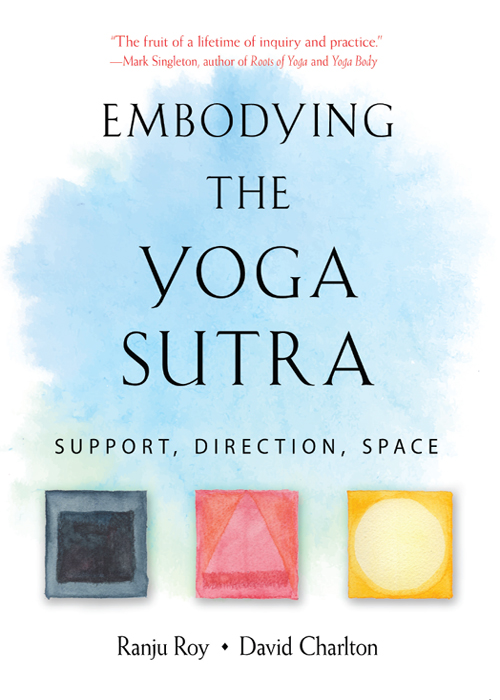
Praise for Embodying the Yoga Sutra
Unassuming, generous, and brilliant, Dave Charlton and Ranju Roy have been a steady source of inspiration for me for over twenty years. In this book, you are getting the no-nonsense, deep-reaching, honest, real-life yoga lived and breathed by these two wonderful teachers. This is the most readable book on the Yoga Sutra I have ever come across. It will be required reading on almost every yoga teacher training course in the country before very long.
Tara Fraser, director of Yoga Junction, author of Total Yoga,
The Easy Yoga Workbook, Yoga Bliss, Astanga Yoga for You,
and others
Through their many years of dedication to the path of yoga, Ranju and David have brought the ancient insights of the often terse and complex Yoga Sutra to life. Here is something differentmore than just a commentarya way to understand and embody the wisdom held within these enigmatic threads. It's both an academic as well as a practical book for the dedicated practitioner wanting to deepen their experience of the yogic mysteries.
Sebastian Pole, herbalist, yogi, and
co-founder of Pukka Herbs

for Lindy and Gail
and
for Peter
This edition published in 2019 by Weiser Books, an imprint of
Red Wheel/Weiser, LLC
With offices at:
65 Parker Street, Suite 7
Newburyport, MA 01950
www.redwheelweiser.com
2019 Ranju Roy and David Charlton
All rights reserved. No part of this publication may be reproduced or transmitted in any form
or by any means, electronic or mechanical, including photocopying, recording, or by any
information storage and retrieval system, without permission in writing from Red Wheel/Weiser,
llc. Reviewers may quote brief passages. Previously published in the UK in 2019 by
Yoga Words, an imprint of Pinter & Martin Ltd, ISBN: 978-1-78066-480-4.
ISBN 978-1-57863-688-4
Library of Congress Cataloging-in-Publication Data available on request
Cover and interior design by Kathryn Sky-Peck
Cover art TK
Interior illustrations Ranju Roy
Sanskrit calligraphy Charles Cox
Typeset in in Adobe Text Pro
Printed in Canada
MAR
10 9 8 7 6 5 4 3 2 1
www.redwheelweiser.com/newsletter
Contents
Introduction
Most students and teachers of yoga in the Western world will have come across Patajali's Yoga Stra. Written about 2,000 years ago, this collection of 195 aphorisms has come to represent the foundation and pinnacle of the yoga tradition. The Sanskrit is dense, technical and brief: scholars across the world, and particularly since the late 19th century, have spent years analyzing and interpreting their meaning. Yet, for the vast majority of today's students, the Yoga Stra has little relevance to their own practice. Most will not have read Patajali's original text, and the various translations and commentaries in existence vary considerably in their emphasis.
Following the footsteps of our primary teachersPeter Hersnack, Paul Harvey and T.K.V. Desikacharwe believe that far from being an esoteric and academic text, the Yoga Stra is the key to transforming the way we do yoga. Each of these three extraordinary teachers illuminated aspects of the text and practice that brought an ancient teaching alive and made it fresh and contemporary. They moved it from the abstract to the practical: how it can affect the body (in sana), the breath (in pr yma), the mind (in meditation), and the lived reality of our livesin relationship to others. The Yoga Stra is a treasure trove of suggestions for both practice and for life. We set out to write a book that took this key principlethat the Yoga Stra is a living textto explore how specific stras can deepen and change various aspects of our practice and our lives.
yma), the mind (in meditation), and the lived reality of our livesin relationship to others. The Yoga Stra is a treasure trove of suggestions for both practice and for life. We set out to write a book that took this key principlethat the Yoga Stra is a living textto explore how specific stras can deepen and change various aspects of our practice and our lives.
At the heart of our teaching is the concept of viniyogathe appropriate application of techniques to the individual. One crucial aspect of our approach, arising particularly from Peter Hersnack, is the importance of bhvanaimages that play through your mind as you practice. In sana and pr yma, how you place your thoughts is as important as where you place your limbs. Indeed bhvana (which is sometimes translated as meditation) does not only happen sitting cross-legged with your eyes closed, but can infuse every aspect of your waking life. Our hope is that by understanding the meaning of the key yoga stras we present in this book, you may apply concepts such as these both on and off the mat.
yma, how you place your thoughts is as important as where you place your limbs. Indeed bhvana (which is sometimes translated as meditation) does not only happen sitting cross-legged with your eyes closed, but can infuse every aspect of your waking life. Our hope is that by understanding the meaning of the key yoga stras we present in this book, you may apply concepts such as these both on and off the mat.
Most readers will be unfamiliar with many of the Sanskrit words and terms used, so we have tried to break these down etymologically to draw out the richness of associationthe poetry, if you likeof the stras. Where we have kept to the original Sanskrit words, we have used italics and also diacritical markings. Please refer to the glossary for a discussion on some basics about Sanskrit and its pronunciation. Where words have become more commonly understood in English (for example, yoga, stra, sana and pr yma), we have dispensed with the italics.
yma), we have dispensed with the italics.
About the Book
We begin each chapter with a single yoga stra (except , which has two), both in Devanagari and Romanized script, and then translated into English. A brief commentary on the stra follows, explaining some of the key terms. Each chapter then goes on to provide more context, both in terms of where the stra occursand in some cases, the stras preceding or following itand how its teachings can be understood in our modern context.
There is no strict chronology to the chapters, nor are the stras in order, so the reader can dip in and out as they choose. The book is not a commentary on the complete Yoga Stra: there are plenty of excellent translations already available should you wish to study the whole text in detail. Instead, over 16 chapters we have chosen to focus on 17 key stras which have immediate relevance to our practice. Further stras that relate to the main theme are then introduced and discussed in the body of each chapter.
There is no dearth of beginners' guides, resources and yoga courses available online and in bookshops. Rather than aimed at beginners, this book is intended for practitioners who are already familiar with the basics but would like to extend their knowledge of yoga to explore its history, philosophy and spiritual aspects, and how we might apply these in a modern context. We do not assume any prior knowledge of Sanskrit, however, and have endeavored to keep the linguistic explanations as clear and straightforward as possible. For ease of reference, we have included a glossary of Sanskrit terms at the back of the book, alphabetized according to our standard Roman system.

Throughout the book, a common motif appears: the three terms that make up the subtitle: support, direction and space. This triumvirate was formulated by Peter Hersnack and colored much of his brilliant and inspirational teaching. It is in many ways the most important touchstone for us. Only when you take support on something can a direction arise, which in turn opens up a spaceand a spaciousnessin your practice, and in your life. This image works, as you will discover through much of the book, both as a metaphor
Next page
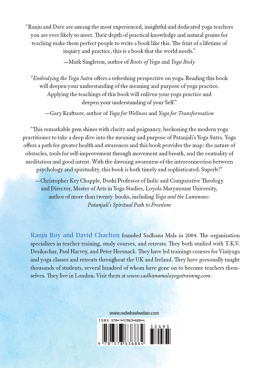


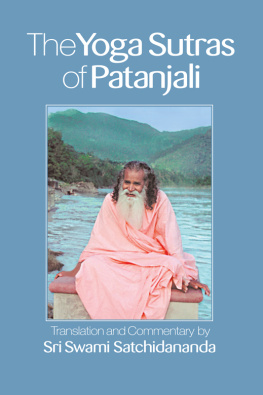
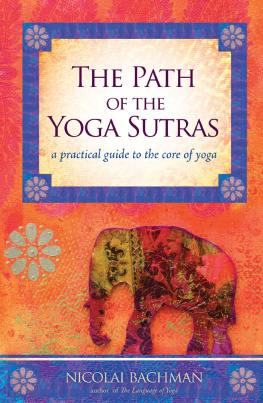
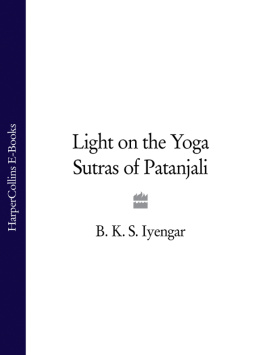


 yma), the mind (in meditation), and the lived reality of our livesin relationship to others. The Yoga Stra is a treasure trove of suggestions for both practice and for life. We set out to write a book that took this key principlethat the Yoga Stra is a living textto explore how specific stras can deepen and change various aspects of our practice and our lives.
yma), the mind (in meditation), and the lived reality of our livesin relationship to others. The Yoga Stra is a treasure trove of suggestions for both practice and for life. We set out to write a book that took this key principlethat the Yoga Stra is a living textto explore how specific stras can deepen and change various aspects of our practice and our lives.